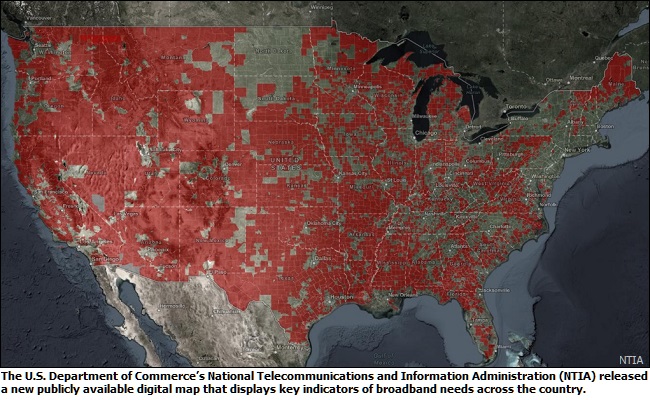
|
|

|
|
| April 19, 2024 |
|
New federal broadband maps show stark differences in access, affordability 
OAKLAND - For the first time, a federal agency has released a comprehensive online map clearly depicting what experts have long warned: Many parts of America — largely in poor, rural and tribal areas — lack quality and affordable broadband internet access.
The National Telecommunications and Information Administration, part of the Department of Commerce, published the map Thursday. The interactive online graphic combines data from a variety of sources both public and private: speed test data provided by M-Lab, Ookla and Microsoft, as well as overlays of census data. The map offers some granular views of internet access in communities across the United States. It shows that in one largely working-class and Latino census tract in east Oakland, California, more than 26 percent of people do not have household internet access despite having commercial providers. The cost of internet access can often be a barrier for low-income households. Meanwhile, just a few miles to the north, in a generally wealthier and whiter neighborhood, that figure falls to just 6 percent. All households in both neighborhoods have access to the same level of commercially available service, but affordability stands as a major issue that prevents many people from signing up. “As we release this important data to the public, it paints a sobering view of the challenges facing far too many Americans as they try to connect to high-speed broadband and participate in our modern economy,” Commerce Secretary Gina M. Raimondo said in a statement. The problem of uneven broadband access has been more widely recognized in recent years, with local politicians sounding the alarm. The mayors of five cities across the South wrote in an op-ed Wednesday: “Across Louisiana, Mississippi, Arkansas and Alabama, one-fifth of our populations live in households without Internet.” The map comes at a time when the White House is pushing an infrastructure bill that aims, among many other objectives, to “bring affordable, reliable, high-speed broadband to every American, including the more than 35 percent of rural Americans who lack access to broadband at minimally acceptable speeds.” Democrats and Republicans in Congress are currently debating what sort of compromise they can come to on the infrastructure bill. The Federal Communications Commission currently defines broadband as a download speed of 25 megabits per second and an upload speed of 3 Mbps. However, households that may need to share such a connection across multiple phones and computers for entertainment, educational and professional purposes often find that this minimal level of service is not enough. In February, Comcast doubled the speed of its low-cost program, known as Internet Essentials, from 25 Mbps to 50 Mbps. Comcast owns NBCUniversal, the parent company of NBC News. During the height of the pandemic, many school districts and communities rushed to mitigate the digital divide as students had to get online in order to attend remote school. As a result, community groups pushed companies for more transparency regarding who lacked access, and who had already signed up for low-income programs. The Biden administration is now hoping to take this broadband data and push for more investment in broadband access, which some cities have already done on their own through private fundraising. (Source: NBC News) Story Date: June 18, 2021
|